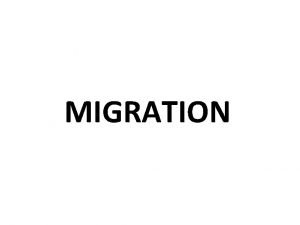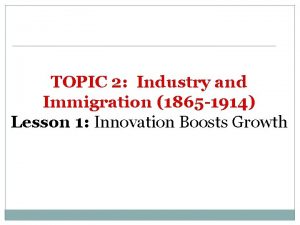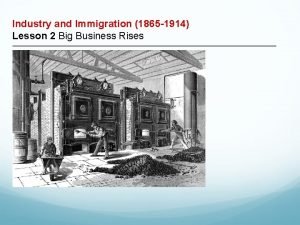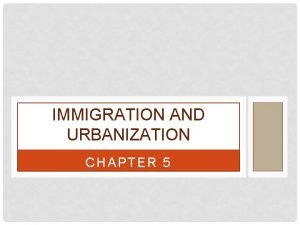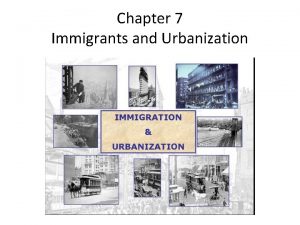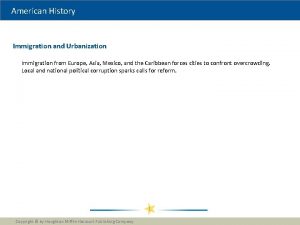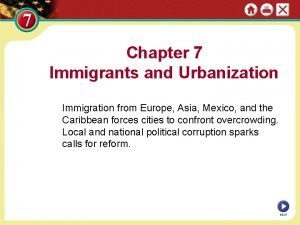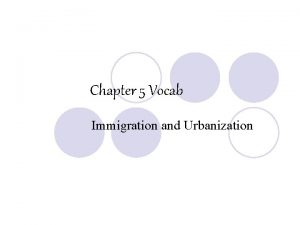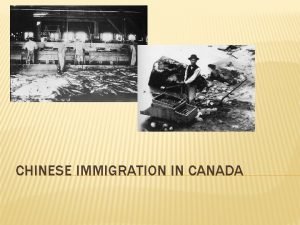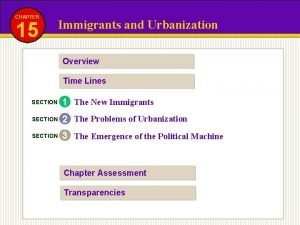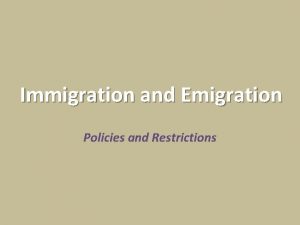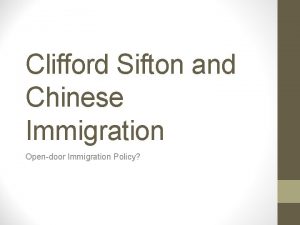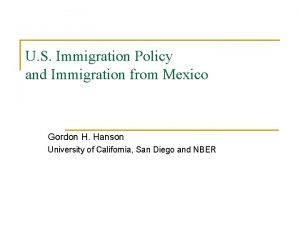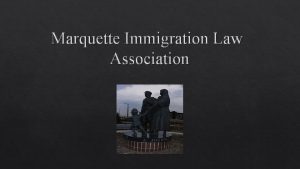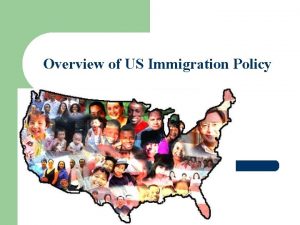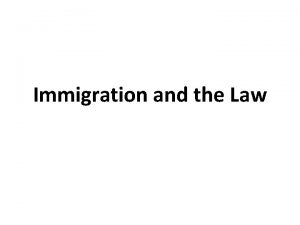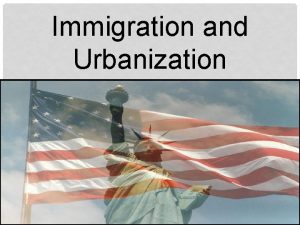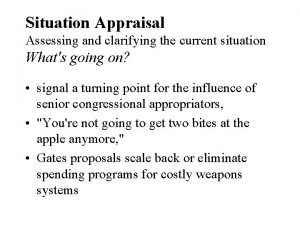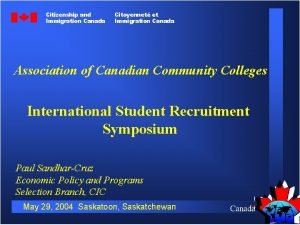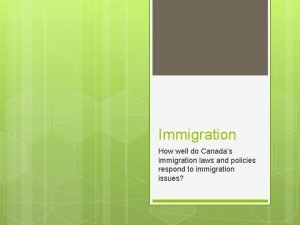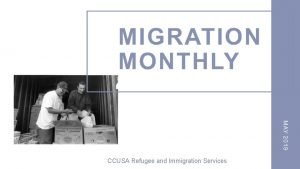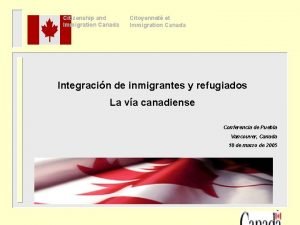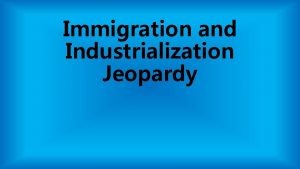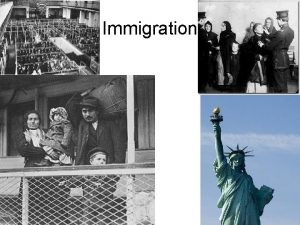Immigration Situation and Immigration Policy in the EU















































- Slides: 47

Immigration Situation and Immigration Policy in the EU Member States Fall semester 2018/2019 Presented on 8. 01. 2019 GAUTHIER JAUNET MYKOLA KRYVITSKYI JAKUB LISOWSKI

Immigration crisis in Europe A comparison between arrival countries in the Mediterranean and destination countries in Northern Europe using the examples of Italy, Greece and Denmark.

Structure: ● ● ● ● Introduction Context Immigration situation Immigration policies Comparison between Greece, Italy and Denmark Possible issues for Europe Conclusion

Introduction

Objectives ● Analyse the immigration situation ● Evaluate immigration policies ● Contrast Greece, Italy and Denmark in multiple areas ● Critically assess the countries’ responses to increased immigration ● Suggest improvements to solve existing problems and prevent more in the future

Scope and justification The presentation focuses on the European refugee crisis of 2015 through the scope of three countries: Greece, Italy and Denmark. Both the immigration situation as well as specific policies are analysed, including the historical context. The findings are then compared and improvements are suggested on the basis of the findings. The countries were chosen in order to compare Mediterranean arrival countries with a destination country in Northern Europe such as Denmark. Comparing the immigration situation as well as specific policies helps paint a detailed picture of the differences in the attitudes and experiences of mass migration in these drastically different regions of Europe.

Research questions Why do immigration figures relate to the numbers of asylum applicants in a given country? What are the main differences in immigration policy between Greece, Italy and Denmark? How can immigration policy be improved to deal with current and future issues related to migration? What was the impact of the European migrant crisis on economic, demographic, social aspects in these countries? What are the issues arising from mass migration in the Mediterranean?

Research methods Literature review: academic papers are analysed with regards to the research questions. Quantitative analysis: data related to migration is analysed and findings are presented. Qualitative analysis of political discourse and social attitudes towards immigration is performed.

Context

European refugee crisis ● 2015 ● pattern of increased migration since mid-20 th century ● Mediterranean arrivals: Syrians (46. 7%), Afghanis (20. 9%) and Iraqis (9. 4%) in 2015 ● over 14, 000 dead or missing since 2015 in the Mediterranean ● Europe only a small part of worldwide migration flows UNHCR data portal - Situations. Mediterranean Situation. Available at https: //data 2. unhcr. org/en/situations/mediterranean. Retrieved 1 Jan 2019.

● ● Eastern Mediterranean route is the most prominent Asylum applicants as % of population are similar for Italy, Greece and Denmark Predominantly first-time asylum applicants in all countries Surge in asylum applications in 2015 Dörrbecker, M. (2015). European migrant crisis. Asylum applicants in Europe between 1 January and 30 June 2015 [Map]. Available at https: //en. wikipedia. org/wiki/European_migrant_cri sis, Retrieved 1 Jan 2019.

Own interpretation based on UNHCR data. Available at https: //data 2. unhcr. org/en/situations/mediterranean. Retrieved 1 Jan 2019.

States applying Dublin instruments Dublin regulation EU-Denmark agreement non-EU member states with an agreement to apply the provisions ● ● ● Framework for asylum applications in Europe Refugees must apply for asylum in country of arrival to the EU Gives countries the right to deport refugees to country of arrival Highly controversial and criticised by human rights groups First signed in 1990, amendments adopted in 2003 and 2013. Partially suspended in 2015 by multiple countries States applying Dublin instruments [Map]. (2014, November 10). In Wikipedia. Retrieved January 5, 2019, from https: //en. wikipedia. org/wiki/Dublin_Regulation

Immigration situation

Greece ● until the 1970 s - country of emigration ● large numbers of immigrants over the last three decades ● initially from Balkans and Eastern Europe, later from Asia and Africa (Figgou, 2016) ● estimates of 1, 300, 000 migrants, 390, 000 undocumented (Maroukis, 2012) ● over 1, 000 sea arrivals since 2015 UNHCR data portal - Situations. Mediterranean Situation. Available at https: //data 2. unhcr. org/en/situations/mediterranean. Retrieved 1 Jan 2019.

● ● Vast majority of migrants in 2015 arrived in the EU through Greece Border crossing with Macedonia a controversial issue Despite the high volume of sea arrivals, much safer than the Central Mediterranean route Sharp decrease in arrivals between 2015 and 2016 BBC. (2016). Migrant crisis: Hundreds cross from Greece into Macedonia. Retrieved January 3, 2019, from https: //www. bbc. com/news/world-europe 35805010

Italy ● in the past a country of mass emigration, now increasingly larger immigrant population ● 5, 144, 440 foreigners resident in Italy as of Jan 1 st 2018 ● Three largest immigrant groups resident in Italy: Romanians (1, 190, 091), Albanians (440, 465) and Moroccans (416, 531) ● nearly 500, 000 sea arrivals since 2015 UNHCR data portal - Situations. Mediterranean Situation. Available at https: //data 2. unhcr. org/en/situations/mediterranean. Retrieved 1 Jan 2019. ISTAT. (n. d. ). Resident foreigners on 1 st January - Citizenship. Retrieved January 5, 2019, from http: //stra-dati. istat. it/Index. aspx

Istat, Population and Households. (2018, November 26). NON-EU CITIZENS: PRESENCE, NEW INFLOWS AND ACQUISITION OF CITIZENSHIP [Press release]. Retrieved January 5, 2019, from https: //www. istat. it/en/archivio/224319

● ● Distances travelled between North Africa and Italy/Malta are significant which leads to many deat in this part of the Mediterranean Accounts for the majority of dead or missing person according to UNHCR data Less than half the sea arrivals since 2015 compared Greece Multiple routes from both Libya and Tunisia Davies, L. (2014, June 25). Europe's migrant influx: 'we need help but we don't know where from'. Retrieved January 5, 2019, from https: //www. theguardian. com/world/2014/jun/25/-sp-boat-migrants-risk-everything-for-a-new-life-in-europe

Denmark ● rapid increase in immigration in the 1960 s, mainly for labour ● immigration heavily limited since ● 351, 182 immigrants from ‘non-western countries’ living in denmark in Q 4 2018 ● 10, 849 resident permits on the basis of asylum granted in 2015 (21, 000 applications) ● over 4, 000 new Danish citizens in 2015 from outside the EU

Immigrants and their descendants. (Statistics Denmark. ). Retrieved January 6, 2019, from https: //www. dst. dk/en/Statistik/emner/befolkning-og-valg/indvandrere-og-efterkommere

Immigrants and their descendants. (Statistics Denmark. ). Retrieved January 6, 2019, from https: //www. dst. dk/en/Statistik/emner/befolkning-og-valg/indvandrere-og-efterkommere

Immigration policies

Greece ● first policies introduced in the late 1990 s ● estimated 1, 820, 000 migrants deported between 1991 and the first half of 1999 (Antonopoulos & Winterdyk, 2006) ● Eurobarometer study (Kiprianos et al. , 2003) from 1989 showed Greeks to be the most tolerant of immigrants in the EU ● Balkan conflicts and recently the eurozone crisis were a negative influence on Greece’s openness to immigrants ● migration is not an important issue in the Greek political scene

December 2009: new bill introduced by PASOK Absence of institutional policy Despite large numbers of migrants there was a complete lack of institutional policy addressing immigration until the 1990 s. It would facilitate naturalisation of firstgeneration immigrants and enable citizenship acquisition for immigrant children born in Greece. February 2012: Supreme court finds bill to be in violation of the constitution. 2010 1998 2012 2009 Some institutional arrangements introduced between 1998 and 2009 These policies were aiming to regulate issues of entry and legal residence of immigrants -ius sanguinis March 2010: The new bill (3838/10) is passed by PASOK and SYRIZA parties. Own interpretation based on: Figgou, L. (2016) Constructions of ‘Illegal’ Immigration and Entitlement to Citizenship: Debating an Immigration Law in Greece. J. Community Appl. Soc. Psychol. , 26: 150– 163. doi: 10. 1002/casp. 2242.

The border crossing near Edirne has been a contentious iss between Greece and Turkey due to high numbers of illega border crossings in this area. This lead to a border fence being built along Turkish territory West of the Evros/Meriç river between October 2011 and December 2012. The borde fence is 10, 5 km long and cost 3 million euros to build. It lea to a significant reduction in illegal border crossings from Turkey to Greece. P. (2015, November 19). The course of the Greece–Turkey land border, mostly following the Maritsa (Turkish: Meriç, Greek: Evros) river (depicted in blue), roughly indicating the 12. 5 km border fence (in red) on the Greek side near Edirne, and major highways (in grey). [Map]. In Wikipedia. Retrieved January 4, 2019, from https: //en. wikipedia. org/wiki/Border_barrier#Greece

Italy ● ● ● first immigration law Foschi ( Law) introduced in 1986 increased restrictiveness of immigration policy over time one of the lowest naturalisation rates in Europe continuity in reforms irrespective of the government's overall position ‘Salvini decree’ (2018) proposed further restrictions for asylum seekers, i. e. higher requirements for granting and easier revoking of asylum status Paparusso, A. , Fokkema, T. , & Ambrosetti, E. (2017). Immigration policies in italy: Their impact on the lives of first-generation moroccan and egyptian migrants. Journal of International Migration and Integration, 18(2), 499 -546. doi: http: //dx. doi. org. eur. idm. oclc. org/10. 1007/s 12134 -0160485 -x

Foschi Law Turco-Napolitano Law “Addressed non-EU workers only and aimed to prevent illegal immigration” The law aimed to further restrict immigration by introducing worker quotas as well as detention centres. However, it also aimed to promote integration. 1990 1986 2002 1995 Martelli Law Bossi-Fini Law The law now covered other motives of immigration apart from labour. Main aim was to restrict entry to foreigners. Further repressive policy towards illegal immigrants. Removal of sponsor system. Improvement of border control and police patrols. Own interpretation based on: Paparusso, A. , Fokkema, T. , & Ambrosetti, E. (2017). Immigration policies in italy: Their impact on the lives of first-generation moroccan and egyptian migrants. Journal of International Migration and Integration, 18(2), 499 -546. doi: http: //dx. doi. org. eur. idm. oclc. org/10. 1007/s 12134 -0160485 -x

Denmark ● ● ● increasingly restrictive policy since the early 1970 s issue of migration prevalent in national discussion (1990 s to 2000 s) issues of integration and cultural identity in Denmark increasing support for right-wing populist Dansk Folkeparti integration a strong focus in recent years, i. e. efforts to integrate ghettos

Danish Ministry of Refugees, Immigration, and Integration Affairs. (2010). Gaps in labor market participation between working age Danes, Immigrants of Western Origin, and Immigrants of Non-Western Origin from 2001 to 2008 [Chart]. In Statistical Overview of Integration: Population, Education, and Employment.

Photograph from a Danish ghetto neighbourhood Bispeparken in Copenhagen (left) and Dansk Folkeparti’s anti-censorship campaign from 2007 (right).

Comparison between Greece, Italy and Denmark

A welcoming Europe? http: //www. europarl. europa. eu/external/html/welcomingeurope/default_en. htm https: //data 2. unhcr. org/en/situations/mediterranean

http: //www. europarl. europa. eu/external/ht ml/welcomingeurope/default_en. htm - Even for an arrival country, Greece got 9. 430 asylum seekers and 10. 262 refugees, it’s less than Denmark who got 14. 680 asylum seekers and 17. 737 refugees. Italy is the most touched one by the immigration crisis in 2014 with 93. 662 refugees and 64. 625 Asylum seekers.

http: //www. europarl. europa. eu/external/h tml/welcomingeurope/default_en. htm - 2015 is the highest peak regarding the total number of asylum application in EU. Gap between countries regarding refugees and asylum seekers didn’t really change in comparison with 2014.

http: //www. europarl. europa. eu/external/ht ml/welcomingeurope/default_en. htm - Looking at the graph we can see that the total number of asylum application for EU stay really high. In comparison with 2015, the number of asylum seeker for greece has been multiplied by almost 4. While this number decreased in Denmark.

http: //www. europarl. europa. eu/external /html/welcomingeurope/default_en. htm - In Italy and Greece the numbers are still growing while in Denmark only the number of refugees grew up, the number of asylum seekers there still decrease.

- - This document treat about sea arrivals in Italy, Cyprus and Malta and both sea and land arrivals to Greece and Spain This is a document in continuous development, this image only treat about sea arrivals in 2019 and has been updated the 10 January of 2019. So I invite you to click on the link below to follow how it’s growing: https: //data 2. unhcr. org/en/si tuations/mediterranean - https: //data 2. unhcr. org/en/situations/mediterranean Retrieved the 13/01/2019 In 2018 they estimate the number of dead and missing by seas around 2. 275 people. The lowest estimation since 2014.

- - - Percentage of greek people going back to Greece in 2015 rise almost 50% of total number of immigrants in Greece get the lowest percentage regarding non-EU citizens immigrants in 2015. According to the previous document Denmark get more than Greece. Italy get the highest percentage of non. EU citizens immigrants coming into borders in EUin 2015.

The difference about how immigrants are treated - In Denmark, government is trying to close ghettos in a strict way. https: //www. youtube. com/watch? v=39 ju-dpc. JU 0 - In Greece and Italy there is too many immigrants looking for asylum, that’s why they’re talking about being stricter on borders and about who is admitted as an asylum seeker. https: //www. youtube. com/watch? v=_OECe 9 crgx. Y Here the problem is that Matteo Salvini doesn’t give a real definition of “people who come here to cause trouble”, it’s too vague.

Possible issues for Europe

What has been put in place EU opened safe pathways for relocating people from Greece and Italy in other EU member states, they opened a safe and legal way for asylum seekers to enter Europe like this they don’t have to risk their lives with smugglers. Dublin Regulation is intended to admit immigrants as asylum seeker in the first country where they are controlled by authorities.

Problem encountered by EU Some countries don’t want to accept migrants in their territory so they oppose the migrants quotas proposed by the EU to unclog arrival countries like Italy and Greece, for example the Visegrad group countries. Dublin Regulation’s problem is that it violates the asylum seekers’ rights to travel to their intended destination. Also, it can lead to what happened in 2015 when Hungary was overburdened with asylum applications but had the obligation to process them in line with the agreement.

Conclusion - Greece and Italy are both sea arrivals countries with large number or refugees in 2015 and 2016 Denmark has been applying restrictive policy about immigrants really fast, since 1970. The situation in Greece and Italy is getting worse with immigrants because they have to feed all of those migrants in a economic crisis situation. Europe is trying to help border countries as it can but some european countries are against this tolerance about immigrants. The Dublin Regulation is highly disadvantageous for border countries. How to manage this crisis? Can we try to stop the problem at the source? Try to stop those war instead try to stop migrants? What will be the impact if one of the top five origins of refugees countries ends war, for example Syria?

References Articles Antonopoulos, Georgios A. , and John Winterdyk. "The Smuggling of Migrants in Greece An Examination of its Social Organization. " European Journal of Criminology 3. 4 (2006): 439 -461. BBC. (2016). Migrant crisis: Hundreds cross from Greece into Macedonia. Retrieved January 3, 2019, from https: //www. bbc. com/news/world-europe-35805010 Davies, L. (2014, June 25). Europe's migrant influx: 'we need help but we don't know where from'. Retrieved January 5, 2019, from https: //www. theguardian. com/world/2014/jun/25/-sp-boat-migrants-risk-everything-for-a-new-life-in-europe Figgou, L. (2016) Constructions of ‘Illegal’ Immigration and Entitlement to Citizenship: Debating an Immigration Law in Greece. J. Community Appl. Soc. Psychol. , 26: 150– 163. doi: 10. 1002/casp. 2242. GREEN‐PEDERSEN, C. and KROGSTRUP, J. (2008), Immigration as a political issue in Denmark and Sweden. European Journal of Political Research, 47: 610 -634. doi: 10. 1111/j. 1475 -6765. 2008. 00777. x Kiprianos, Pandelis, Stathis Balias, and Vaggelis Passas. "Greek policy towards immigration and immigrants. " Social Policy & Administration 37. 2 (2003): 148– 164

Maroukis T. (2012). Update report Greece: The number of irregular migrants in Greece at the end of 2010 and 2011. Database on Irregular Migration, June. Available at: http: //irregularmigration. net/. Paparusso, A. , Fokkema, T. , & Ambrosetti, E. (2017). Immigration policies in italy: Their impact on the lives of first-generation moroccan and egyptian migrants. Journal of International Migration and Integration, 18(2), 499 -546. doi: http: //dx. doi. org. eur. idm. oclc. org/10. 1007/s 12134 -016 -0485 -x Wadensjö, E. (2000). Immigration, the labour market, and public finances in Denmark. Swedish Economic Policy Reviw, 7, 59 -83. Retrieved January 6, 2019, from https: //www. government. se/reports/2000/01/swedish-economic-policy-review-volume-7 -no. -2 -theassimilation-of-immigrants-in-the-labour-market-/ Databases Immigrants and their descendants. (Statistics Denmark. ). Retrieved January 6, 2019, from https: //www. dst. dk/en/Statistik/emner/befolkning-og-valg/indvandrere-og-efterkommere ISTAT. (2018. ). Resident foreigners on 1 st January - Citizenship. Retrieved January 5, 2019, from http: //stra-dati. istat. it/Index. aspx Istat, Population and Households. (2018, November 26). NON-EU CITIZENS: PRESENCE, NEW INFLOWS AND ACQUISITION OF CITIZENSHIP [Press release]. Retrieved January 5, 2019, from https: //www. istat. it/en/archivio/224319 Danish Ministry of Refugees, Immigration, and Integration Affairs. (2010). Gaps in labor market participation between working age Danes, Immigrants of Western Origin, and Immigrants of Non-Western Origin from 2001 to 2008 [Chart]. In Statistical Overview of Integration: Population, Education, and Employment.

Other Dörrbecker, M. (2015). European migrant crisis. Asylum applicants in Europe between 1 January and 30 June 2015 [Map]. Available at https: //en. wikipedia. org/wiki/European_migrant_crisis, Retrieved 1 Jan 2019. n. d (2015, November 19). The course of the Greece–Turkey land border, mostly following the Maritsa (Turkish: Meriç, Greek: Evros) river (depicted in blue), roughly indicating the 12. 5 km border fence (in red) on the Greek side near Edirne, and major highways (in grey). [Map]. In Wikipedia. Retrieved January 4, 2019, from https: //en. wikipedia. org/wiki/Border_barrier#Greece States applying Dublin instruments [Map]. (2014, November 10). In Wikipedia. Retrieved January 5, 2019, from https: //en. wikipedia. org/wiki/Dublin_Regulation UNHCR data portal - Situations. Mediterranean Situation. Available at https: //data 2. unhcr. org/en/situations/mediterranean. Retrieved 1 Jan 2019. https: //www. easo. europa. eu/about-us/what-we-do http: //www. europarl. europa. eu/portal/en
 Difference between immigration and emigration
Difference between immigration and emigration Topic 2 industry and immigration
Topic 2 industry and immigration Industry and immigration lesson 5 a nation of cities
Industry and immigration lesson 5 a nation of cities Industry and immigration lesson 2 big business rises
Industry and immigration lesson 2 big business rises Chapter 5 immigration and urbanization
Chapter 5 immigration and urbanization Chapter 7 building vocabulary immigration and urbanization
Chapter 7 building vocabulary immigration and urbanization Chapter 7 building vocabulary immigration and urbanization
Chapter 7 building vocabulary immigration and urbanization Immigration and urbanization new technologies lesson 4
Immigration and urbanization new technologies lesson 4 Chapter 7 building vocabulary immigration and urbanization
Chapter 7 building vocabulary immigration and urbanization Chapter 5 immigration and urbanization
Chapter 5 immigration and urbanization Chinese immigration push factors
Chinese immigration push factors Chapter 15 building vocabulary immigration and urbanization
Chapter 15 building vocabulary immigration and urbanization Hình ảnh bộ gõ cơ thể búng tay
Hình ảnh bộ gõ cơ thể búng tay Ng-html
Ng-html Bổ thể
Bổ thể Tỉ lệ cơ thể trẻ em
Tỉ lệ cơ thể trẻ em Voi kéo gỗ như thế nào
Voi kéo gỗ như thế nào Chụp tư thế worms-breton
Chụp tư thế worms-breton Hát lên người ơi
Hát lên người ơi Môn thể thao bắt đầu bằng từ chạy
Môn thể thao bắt đầu bằng từ chạy Thế nào là hệ số cao nhất
Thế nào là hệ số cao nhất Các châu lục và đại dương trên thế giới
Các châu lục và đại dương trên thế giới Công của trọng lực
Công của trọng lực Trời xanh đây là của chúng ta thể thơ
Trời xanh đây là của chúng ta thể thơ Mật thư anh em như thể tay chân
Mật thư anh em như thể tay chân Phép trừ bù
Phép trừ bù Phản ứng thế ankan
Phản ứng thế ankan Các châu lục và đại dương trên thế giới
Các châu lục và đại dương trên thế giới Thơ thất ngôn tứ tuyệt đường luật
Thơ thất ngôn tứ tuyệt đường luật Quá trình desamine hóa có thể tạo ra
Quá trình desamine hóa có thể tạo ra Một số thể thơ truyền thống
Một số thể thơ truyền thống Cái miệng nó xinh thế chỉ nói điều hay thôi
Cái miệng nó xinh thế chỉ nói điều hay thôi Vẽ hình chiếu vuông góc của vật thể sau
Vẽ hình chiếu vuông góc của vật thể sau Thế nào là sự mỏi cơ
Thế nào là sự mỏi cơ đặc điểm cơ thể của người tối cổ
đặc điểm cơ thể của người tối cổ V cc
V cc Vẽ hình chiếu đứng bằng cạnh của vật thể
Vẽ hình chiếu đứng bằng cạnh của vật thể Fecboak
Fecboak Thẻ vin
Thẻ vin đại từ thay thế
đại từ thay thế điện thế nghỉ
điện thế nghỉ Tư thế ngồi viết
Tư thế ngồi viết Diễn thế sinh thái là
Diễn thế sinh thái là Dạng đột biến một nhiễm là
Dạng đột biến một nhiễm là Bảng số nguyên tố
Bảng số nguyên tố Tư thế ngồi viết
Tư thế ngồi viết Lời thề hippocrates
Lời thề hippocrates Thiếu nhi thế giới liên hoan
Thiếu nhi thế giới liên hoan
